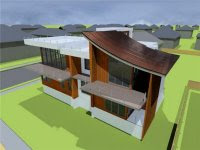Saturday, March 5, 2011
Alternative Energy: A Healthy Choice
Today's guest blog is by Krista Peterson, a recent graduate from the University of Central Florida who is an aspiring writer with a passion for the health and safety of our community and environment.
The EPA lists three goals of green building: improving efficiency in the use of energy, water, etc.; safeguarding the health and productivity of the building’s occupants; and decreasing waste and pollution generated by the structure. All three of these goals have distinct benefits to our daily lives as well as to the natural environment.
Improving Efficiency
Many of us have heard this over and over, but it is worth repeating: energy efficiency is not just good for the earth; it’s good for the wallet. The fewer resources we use, the less we have to pay for them. Despite this common-sense principle, efficiency can sometimes be difficult to implement, particularly in more extreme climates where making the indoor air a more comfortable temperature takes more energy. The EPA estimates that 43-60% of an inhabited structure’s energy expenditure goes towards heating and cooling. Renewable sources of electricity like solar cells are ideal, but not suited to every building or budget. Instead, energy use can be reduced through the use of blown-in insulation and double-paned windows with high-efficiency glass to prevent the heated or cooled air from leaking out. Even steps as simple as applying caulk or weather-stripping to cracks and gaps around windows and doors is an application of green building principles.
Safeguarding Health
Even if something is “natural,” it is not necessarily healthy or good for the environment. Asbestos, for example, is a naturally-occurring mineral found in deposits all over the world, but its use in construction materials is not considered environmentally friendly because of the danger it poses to public health. The mineral was once commonly used in nearly every structural component of an average building, since it added strength and heat-resistance, but we now know how dangerous asbestos is. When breathed into the lungs, it can cause health problems like lung scarring, asbestosis, or symptoms of mesothelioma, a rare and aggressive cancer of the lining of the lungs. Sadly, mesothelioma life expectancy is poor, with only about 10% of patients surviving for five years after diagnosis. Asbestos has now been replaced with safer alternatives such as fiberglass, cellulose, or rock wool.
Decreasing Waste
Finally, sustainable architecture is designed to reduce waste both in the construction and occupancy of the building. This may be accomplished by using renewable materials such as sustainable lumber or other plant matter or recycling other materials like stone or metal. Some construction projects can even reuse industrial byproducts like coal combustion waste, foundry sand, or demolition debris. Additional features allow the inhabitants to do things like reuse greywater for irrigation or other non-drinkable purposes.
When green architects put these principles into effect, they improve our quality of life along with the natural environment in ways we might not necessarily expect. For example, mesothelioma symptoms have even been diagnosed in dogs and cats, and just about any creature with lungs is at risk. As we reduce our use of natural resources and use them as efficiently and safely as possible, we will be able to work toward a more sustainable way of life for ourselves and future generations.
Subscribe to:
Post Comments (Atom)





No comments:
Post a Comment